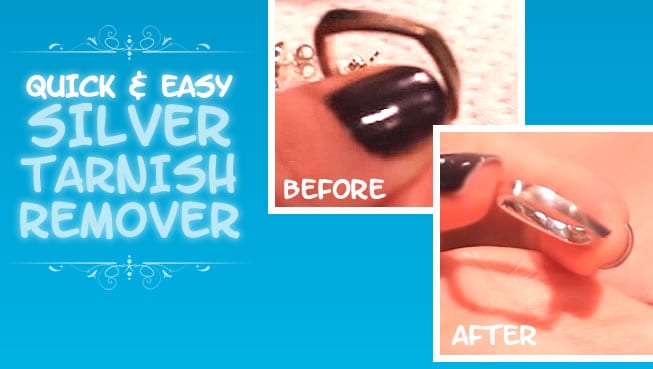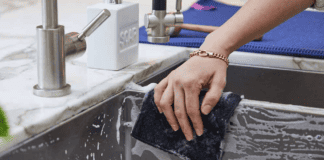Stains happen to the best of us – and always in the most inconvenient locations, right?
Common clothing stains fall under 3 main categories: oil-based, water-based and protein-based. When treating stains, there are a few things to take into consideration:
- What is the stain from (i.e. blood, spaghetti sauce, blueberries, etc.)
- How long has the stain been there (fresh, a week, um – a very long time… etc.)
- What material is the stain on (i.e. cotton, polycottons)
These are the first three questions that you should run through your mind as soon as you go into stain-fighting mode. Now that we’ve got that covered, I’ll review common solutions for each type of stain and how to treat them. Always keep in mind that it’s best to read and follow care labels, and always test on a small area first, especially with delicate fabrics.
Stains can be a pain. Enough said. Learn how to keep your boots clean throughout the winter with How To Get Salt Stains Out Of Shoes.
Oil-Based Stains
Oil-based stains are among the most common stain you will encounter. They often come from food, which can happen from dropping a meatball on yourself to finding oil residue on your shirt after a meal (I’m guilty on both accounts). Grease can single-handedly be responsible for the downfall of wardrobes everywhere. Ever felt like those stains just won’t wash out? Well, keep it simple and prepare to be amazed: my grease-fighting secret weapon for laundry happens to be original blue Dawn! It’s great at cutting kitchen grease, and let me tell you, it does the same thing on oil stains. I tried this out a few years ago and since then, I’ve just kept a bottle right in the laundry area and use it to pre-treat all of laundry stains (more on that later). I’m all into hacks and alternative uses for simple products and this is one of them.
Food, Oil & Grease Stains
Blot
Start by removing any excess food to the best of your abilities. Stick your hand down the garment to separate the stained area from the rest of the garment and begin to blot the clothing as needed with paper towel to get as much oil or grease off as possible.
Absorb
Sprinkle on corn starch or baby powder over the stain which will soak up any excess oil and to help cleanse the fibers. The goal is to have the powder act as a ‘sponge’ to absorb whatever has been spilled before it sets, especially if you can’t launder it right away. In fact, I now keep a small bottle of baby powder in my glove box for just this reason. After a few moments, remove whatever powder was used from the clothing carefully (just shake it off), as you don’t want it to spill or stain another area.
Pre-treat
For cottons or poly-cottons, apply a quarter-sized squirt of the blue Dawn directly to the stain. With Dawn covering the stain, rub soap in using the fabric between your fingers. Now, throw the garment into the laundry machine. Dawn is a great suds creator, so be mindful that for front load high efficiency (HE) machines, it may increase the wash time. Also, I don’t recommend placing more than 2-4 garments which have had this pre-treater technique applied into one load for the same reason.
Delicates
Always check the labels on a product before using it to ensure it won’t damage the fabric of whatever you are trying to clean. For delicate fabrics, try using a specialty stain remover or enzyme pre-treater, testing on a small, inconspicuous area first. Launder using the hottest water safe for the fabric.
Drying
I recommend allowing the clothing to air dry afterwards, since it will help prevent any lingering oil or grease to set into the clothing (which heat can do).
Removing Makeup Stains
With beauty products such as lipstick, mascara and foundation, you can look to follow many of the same steps as above. Sprinkle the stain with baking soda and gently scrub with an old toothbrush. You’ll notice the baking soda starts to ball – this means it’s working! Apply a little more baking soda until you notice it isn’t balling anymore, indicating it’s absorbed all of the oil. Carefully dust off or shake off the baking soda from the clothing, making sure not to get it anywhere else. You can either use a stain remover or an enzyme pre-treater with water to help lift and remove the stain before washing. Be sure to rub your product into the stain well. Once complete, you can launder as usual. Again, I suggest letting the clothes air dry afterwards – better safe than sorry!
Water-Based Stains
The stress of spilling coffee on yourself first thing in the morning might be the worst start to your day, but fortunately, this is the easiest stain category to deal with! Water-based stains can often be cleaned in a normal wash cycle! These stains are caused by coffee, tea, wine, fruit or water-based ink. For stains that are a little more stubborn, here are some tips to help you out.
Blot
It’s always best to deal with the stain when it’s fresh. Start by sponging the spot with cold water.
Be gentle
You don’t want to rub at stains – it can cause it to spread and potentially cause damage to the material. That’s why blotting and agitating lightly is important. Always use a patting motion when blotting and when agitating with a toothbrush, imagine you are brushing a soft tomato or peach, that’s about how hard you want press. Otherwise, you’ll drive the stain deeper into the fabric.
Cold soak
You can also try soaking it in cold water for around 30 minutes. Cold water is the best for rinsing a stain, since it won’t set the stain and will make it easier to clean in the wash.
Pre-treat
Use a laundry pre-treater (you can use plain blue Dawn, as above) or a stain remover to help lift away and eliminate the stain before washing. Follow the care instructions on the item to determine how to launder it accordingly.
Protein-Based Stains
New moms and gym fiends, take note! Protein-based stains are among the most troublesome and most time-consuming stains to remove, but are not impossible! They include things like blood, sweat, grass and mud. As with all stains, treating it immediately will help make removing it easier.
Pre-soak
Soak protein-stained clothing in cold to lukewarm water. Protein stains will set if exposed to hot water, an iron, or a dryer. Add an enzyme cleaner and let the product do it’s magic – you can use one specifically designed for laundry – they are fantastic!
Sweat stains
For sweat stains, you can also try pre-treating using baking soda or vinegar. Make a paste of baking soda and water and rub it directly into perspiration stains on your clothing. If the stain is difficult to remove, let the paste dry for a few hours before washing. With vinegar, just pour a bit directly onto the stain and rub it into the fabric before placing it into the washer. Not only will it help remove the stain, but it will help to deodorize any lingering smells!
Blood stains
For fresh blood stains, rinse the stain under cold water and try to wash away as much as possible. Mix a little water with salt to create a paste to saturate the stain. Rub the salt water paste into the stain. The graininess of the salt will help loosen any remaining bodily fluids and it’s dehydrating properties will work to remove it from the clothing fibres. If you don’t have salt available, try using dish soap instead. Wash as you normally would with cold or lukewarm water so as not to set the stain. Skip the dryer if you can!
For dry blood stains, I have a few unique suggestions for you! Toothpaste and saliva. Use toothpaste on fabrics that can be washed in a washing machine or by hand. Apply toothpaste to the blood stain and let it dry. Rinse with cold water. You’re probably wondering about saliva… Believe it or not, the enzymes in saliva which help digest your food can also break down proteins in blood. It might sound gross, but you can spit on the blood stained area, rub it out and then soak in cold water. It really works! Quick story, during her final bridal gown fitting, my sister pricked her finger on a pin and blood spilled front and centre on her gown. Without blinking, both the seamstress and I immediately spit into our hand to attempt to get the stain out. Disaster averted!
No heat
I can’t say this enough – do not place any protein stain into the dryer or else you’ll permanently set the stain. Wait until the stain is all gone before laundering or drying with heat. You’ll be glad you did!
Don’t let stains get you down any longer! Remember to always read and follow the labels, test on an inconspicuous area first, and air dry JUST in case. Oh, and treat the stain as soon as it happens- you’ll thank yourself later! From spaghetti sauce to oil spills to blueberry splotches, you are now fully equipped to deal with any stain mishap that comes your way.
What’s the craziest stain you’ve ever had to clean? Share with us!
Disclosure: I’ve been working with Dawn on the very exciting Alternative Uses project to share some amazing ways you can use it around the house!
If you’re looking for more tips and tricks to keep in mind check out our E-Book Bundle! It gives you access to our e-books My 3-Wave Cleaning System, 50 DIY Cleaning Recipes, and The Complete Guide to Essential Oils!

Looking for a BETTER & EASIER Way to Clean Your Home?
Cleaning Expert Melissa Maker is here to help with her game-changing 3 Wave Cleaning System that will help you clean your house faster and easier than you ever thought possible!

















